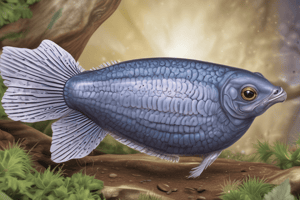Podcast
Questions and Answers
What is the primary location of Fasciola parasites within the human body?
What is the primary location of Fasciola parasites within the human body?
- Skin
- Bile ducts, gallbladder, and liver (correct)
- Intestines
- Lungs
Which stage of the Fasciola life cycle is the infective form that penetrates the human skin?
Which stage of the Fasciola life cycle is the infective form that penetrates the human skin?
- Miracidium
- Egg
- Cercariae (correct)
- Sporocyst
Which two species of Fasciola are found in humans?
Which two species of Fasciola are found in humans?
- _Fasciola hepatica_ and _Fasciolopsis buski_
- _Fasciola gigantica_ and _Fasciola hepatica_
- _Fasciola magna_ and _Fasciolopsis buski_
- _Fasciola gigantica_ and _Fasciolopsis buski_ (correct)
How do humans become infected with Fasciola parasites?
How do humans become infected with Fasciola parasites?
Which clinical manifestation is associated with infection by Fasciola hepatica, a common helminthic infestation in sheep and cattle?
Which clinical manifestation is associated with infection by Fasciola hepatica, a common helminthic infestation in sheep and cattle?
What is the main symptom associated with Fasciola infection?
What is the main symptom associated with Fasciola infection?
Where do the Fasciola parasites migrate to after entering the body?
Where do the Fasciola parasites migrate to after entering the body?
What is the primary mode of transmission for Fasciola infection?
What is the primary mode of transmission for Fasciola infection?
Which drug has been shown to be effective against both Fasciola gigantica and Fasciolopsis buski?
Which drug has been shown to be effective against both Fasciola gigantica and Fasciolopsis buski?
What is the primary method for preventing Fasciola infection?
What is the primary method for preventing Fasciola infection?
Flashcards are hidden until you start studying
Study Notes
Parasitology: An Overview of Intestinal Parasites
Parasitology is the branch of biology concerned with parasites—organisms that live within other organisms, known as hosts. These organisms can cause disease and harm their host's health. In this article, we will delve into one specific type of intestinal parasite: Fasciola.
Fasciola is a genus of flatworms belonging to the family Fascioleidae, order Platyhelminthes, class Trematoda. They are commonly known as liver flukes due to their primary location within the bile ducts, gallbladder, and liver. There are two main species found in humans: Fasciola gigantica and Fasciolopsis buski. Both species are ingested during the larval stage through contaminated food or water.
Life Cycle and Transmission
The life cycle of fasciolids has four stages: egg, miracidium, sporocyst, and cercariae. Eggs from infected animals may contaminate soil and water, where they develop into infective forms called miracidia. When these miracidia reach a snail, they transform into sporocysts, which produce cercariae (the infective form of the parasite). Cercariae penetrate the skin of humans who come into contact with contaminated water or vegetables, initiating infection.
Impact on Host Health
Infection by Fasciola can lead to several clinical manifestations. For example, Fasciola hepatica, a common helminthic infestation in sheep and cattle, is also known to affect humans. Symptoms typically begin after consuming contaminated food or water, such as raw fish or cucumber salad. These symptoms include fatigue, nausea, pain, pale stools, and eosinophilia (elevated white blood cell count).
In the case of Fasciola gigantica, the parasites eventually migrate from the liver to the small intestine. Here, they can cause severe inflammation and damage, leading to chronic diarrhea, malnutrition, and anemia. In endemic areas, fascioliasis can be a leading cause of diarrhea and a significant contributor to malnutrition in children.
To combat these health risks, several drugs have been developed. Triclabendazole, an antihelminthic medication used for treating Fascioliasis, has proven effective against both Fasciola gigantica and Fasciolopsis buski. Other potential treatments include praziquantel and niclosamide, although their efficacy varies depending on the drug resistance profile of each country.
Prevention and Control
Preventing fascioliasis involves recognizing and controlling the intermediate host, which in most cases is a snail. This can be achieved through various actions such as draining or removing sources of standing water, improving sanitation facilities, promoting safe disposal of animal waste, and implementing proper irrigation techniques. Additionally, public education campaigns about the importance of clean drinking water and appropriate cooking methods can help reduce transmission.
As part of a comprehensive approach to control fascioliasis, mass treatment programs using triclabendazole have shown promising results in reducing morbidity and mortality rates associated with this disease. However, continuing surveillance is essential to monitor any changes in the distribution of the disease and the emergence of antiparasitic drug resistance.
In conclusion, understanding the biology, transmission, and impact of intestinal parasites like Fasciola is crucial for developing targeted interventions aimed at preventing and controlling their spread. By raising awareness and implementing evidence-based strategies, it is possible to safeguard human health and improve overall wellbeing in endemic regions.
Studying That Suits You
Use AI to generate personalized quizzes and flashcards to suit your learning preferences.




